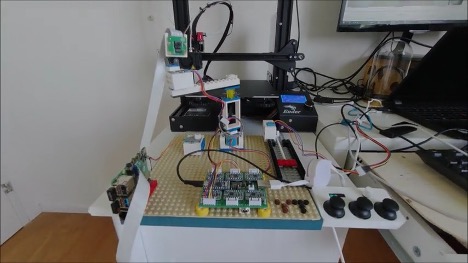Microelectronic engineer Yuksel Temiz has found a unique application for his 3D printer: stop-motion animation. Utilizing multiple prints of figures in various poses, hundreds of photographs, and custom designed props, the scientist has created dozens of short, charming animations.
Stop-motion, in its most basic form, involves taking multiple photographs of an object in different positions so that when it is edited together it gives the appearance of motion. Using his Creality Ender 3D printer, Temiz has rendered figures on various stages of completion and destruction, manifesting the illusion of transformation in many of his pieces.
Detailing his process on his YouTube channel, the maker reveals that his animation of a cat running was created through the use of a personally designed zoetrope constructed from a leftover filament spool, seven different cat prints and around one hundred photographs.
Temiz’s impressive effects, such as a disassembled Benchy, was created with a specially sliced version of the iconic model held together with magnets and more than 180 different photographs.
While it is easy to be impressed with the time-intensive nature of both 3D printing and stop-motion animation, the real surprise is how Temiz accomplished many of these shots at all. Utilizing a self-built Raspberry Pi camera—complete with LEGO swing arm—Temiz was able to get the perfect shots of his prints.
If this setup seems at all familiar to you, it is because Temiz is no stranger to having his designs go viral, having received attention several years ago for his construction of a microscope from LEGOs, with this camera being designed around a similar concept.
 Temiz’s custom camera rig for stop-motion animation.
Temiz’s custom camera rig for stop-motion animation.At a time when the public at large may not fully comprehend the true breadth and utility of 3D printing, it is critical to highlight the work of makers whose prints showcase not just creativity and whimsy, but a desire to connect with the world and people around us in a more bespoke way. Many of the prints featured in Yuksel’s video were custom designed to facilitate the play and growth of his young son. From a light-up hockey puck, to a Tupperware drum machine and a broom handle bicycle connector, this father isn’t just “making toys,” he’s finding a way to connect his own interests with that of his child.
Who knows, given the engineer’s success in DIY stop motion, maybe he’ll be able to work on the next award-winning feature from LAIKA Studios, which relies heavily on 3D printing to produce its films. If so, Temiz may have a chance to get off the desktop and grab the reins of a PolyJet 3D printer from Stratasys, with which LAIKA produces its full-color stop-animation puppets.
Subscribe to Our Email Newsletter
Stay up-to-date on all the latest news from the 3D printing industry and receive information and offers from third party vendors.
You May Also Like
3D Printing Webinar and Event Roundup: April 21, 2024
It’s another busy week of webinars and events, starting with Hannover Messe in Germany and continuing with Metalcasting Congress, Chinaplas, TechBlick’s Innovation Festival, and more. Stratasys continues its advanced training...
3D Printing Webinar and Event Roundup: April 14, 2024
We’re starting off the week’s 3D printing webinars and events at ASTM AMCOE’s 11th Snapshot Workshop and MACH Exhibition. Stratasys continues its advanced training courses, SME is holding a virtual...
Polly the Duck to Receive 3D Printed Bill Prosthetic
In Williamson County, Texas, a story of resilience, innovation, and cross-community effort is unfolding, illustrating the bond between humans and wildlife. All Things Wild, a wildlife rehabilitation center, has been...
3D Printing News Briefs, April 3, 2024: Kickstarter FDM 3D Printer, Artificial Eyes, & More
In 3D Printing News Briefs today, we’re talking about an FDM 3D printer on Kickstarter, advancements in artificial eye creation, and 3D printed solenoids for electromagnets. Then we’ll move on...
































